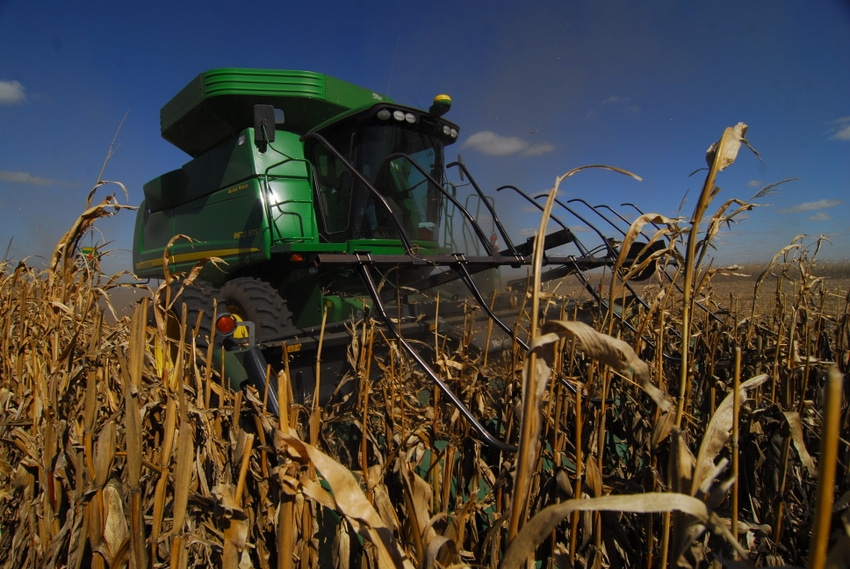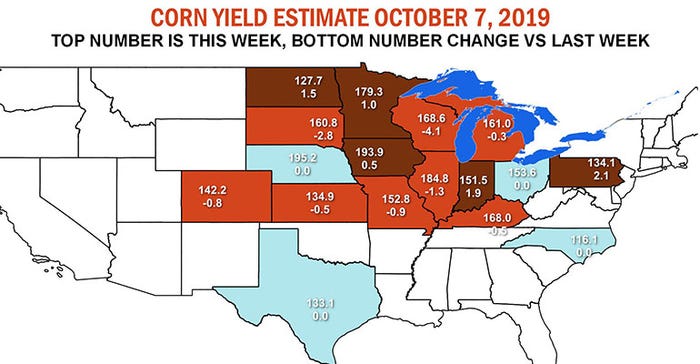
This year’s corn crop will go down in the record books as being notably late from planting through harvest. The latest crop progress report from USDA, out Monday afternoon, showed a slower-than-expected harvest progress of 15% as of October 6, up just four points from a week ago.
“Today crop progress data should ratchet up tension in the grain market as a serious winter storm and cold snap prepares to descend on the northwest part of the growing region for corn, soybeans and spring wheat,” according to Farm Futures senior grain market analyst Bryce Knorr.
Analysts were expecting the agency to show corn harvest progress at 19%. Either way, current totals are well behind 2018’s pace of 33% and the five-year average of 27%.
Most of the crop is now dented after moving from 88% the prior week up to 93%. Typically, all of the crop – 100% in 2018, with a five-year average of 99% -- has reached that physiological stage by this time of year. And 58% of the crop is mature, versus the prior five-year average of 85%.
Crop conditions also deteriorated by a point, with 56% of the crop now rated in good-to-excellent condition. Analysts had expected USDA to hold that rating steady from a week ago. Another 29% of the crop is rated fair (unchanged from a week ago), with the remaining 15% rated poor or very poor (up a point from a week ago). The eastern Corn Belt continues to struggle relative to other areas, with Indiana (28%) and Ohio (29%) with above-average poor-to-very-poor ratings.
“Further damage to corn yields and quality is also possible because maturity is running 44% or more behind average in the Dakotas and Minnesota,” Knorr says. “Corn yield potential dropped more than a half bushel per acre, which could take USDA’s yield Thursday down to 167.3 bpa.”


Soybean harvest is faring somewhat better after moving from 7% complete a week ago up to 14%. That’s still well behind 2018’s pace of 31% and the five-year average of 34%, however. Seventy-two percent of the crop is dropping leaves, versus 2018’s pace of 90% and the five-year average of 87%.
Like corn, analysts expected soybean quality ratings to hold steady last week, with an average trade guess of 55% in good-to-excellent condition. USDA dropped those ratings two points lower, in contrast, to 53% rated good-to-excellent. Another 32% of the crop is rated fair (unchanged from a week ago), with the remaining 15% rated poor or very poor (up two points from a week ago).
“After holding fairly steady for more than a month, soybean ratings dropped last week, knocking a half-bushel per acre off yield potential,” Knorr says. “The decline suggests greater potential for USDA to lower its estimate of production in Thursday’s monthly report by 25 million bushels, perhaps more, taking the national yield down to 47.6 bushels per acre.”
Soybeans could also be affected by killing cold and snow because harvest progress is in single digits in the Dakotas, Minnesota and Iowa, he adds.
The spring wheat harvest made negligible progress last week, advancing just one point to 91% complete. The harvest is typically complete by this time of year. Montana (86%) has been plagued by poor weather in recent days and is the furthest from the finish line at this point. And North Dakota still has 10% of the crop to harvest, with those acres likely to be flattened by snow later this week – bringing a hard end to an already difficult growing season.
Winter wheat plantings crossed the halfway mark to 52%, versus the prior week’s pace of 39% and analyst estimates of 54%. Progress is mostly in line with the pace of recent years, however. And 26% of the crop is emerged, versus 2018’s pace of 28% and the five-year average of 26%.
Click here to access the entire crop progress report from USDA, with additional updates to sorghum, sugarbeets and southern row crops.
About the Author(s)
You May Also Like






